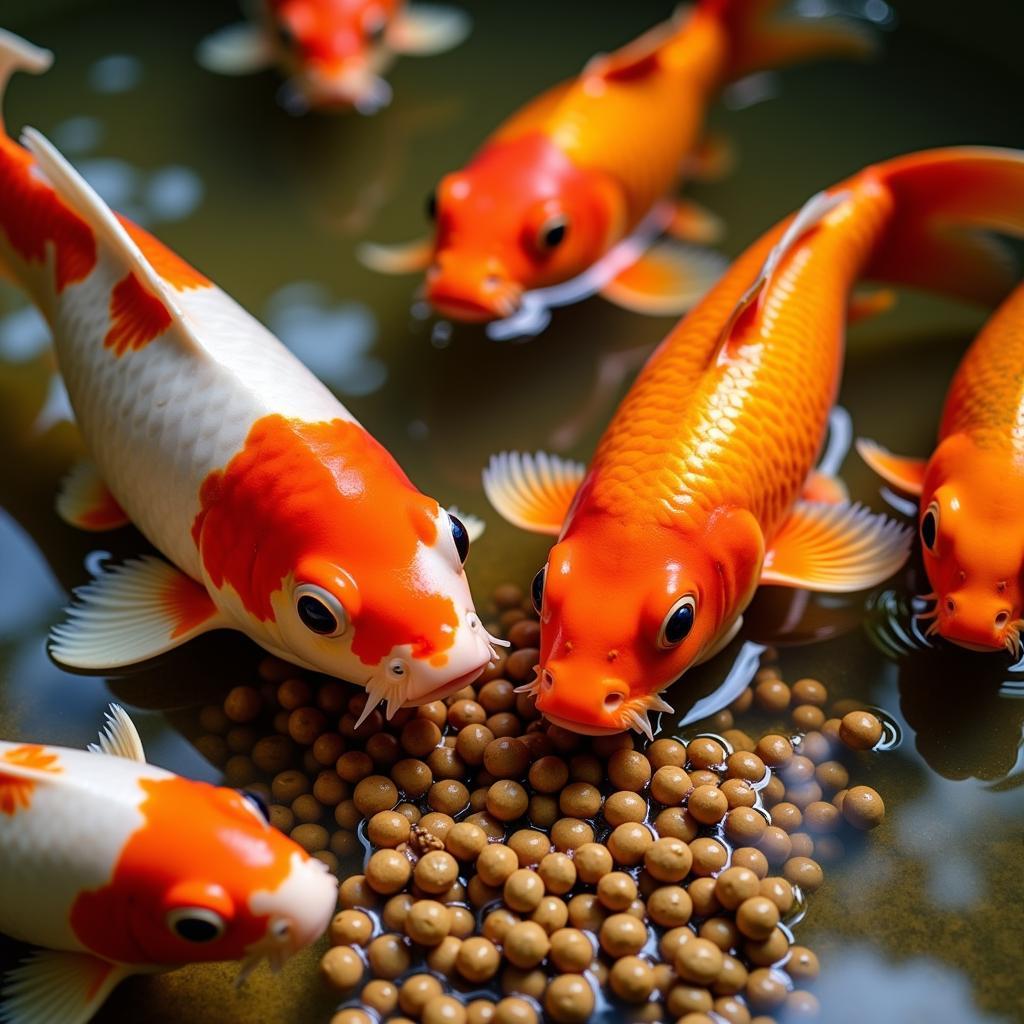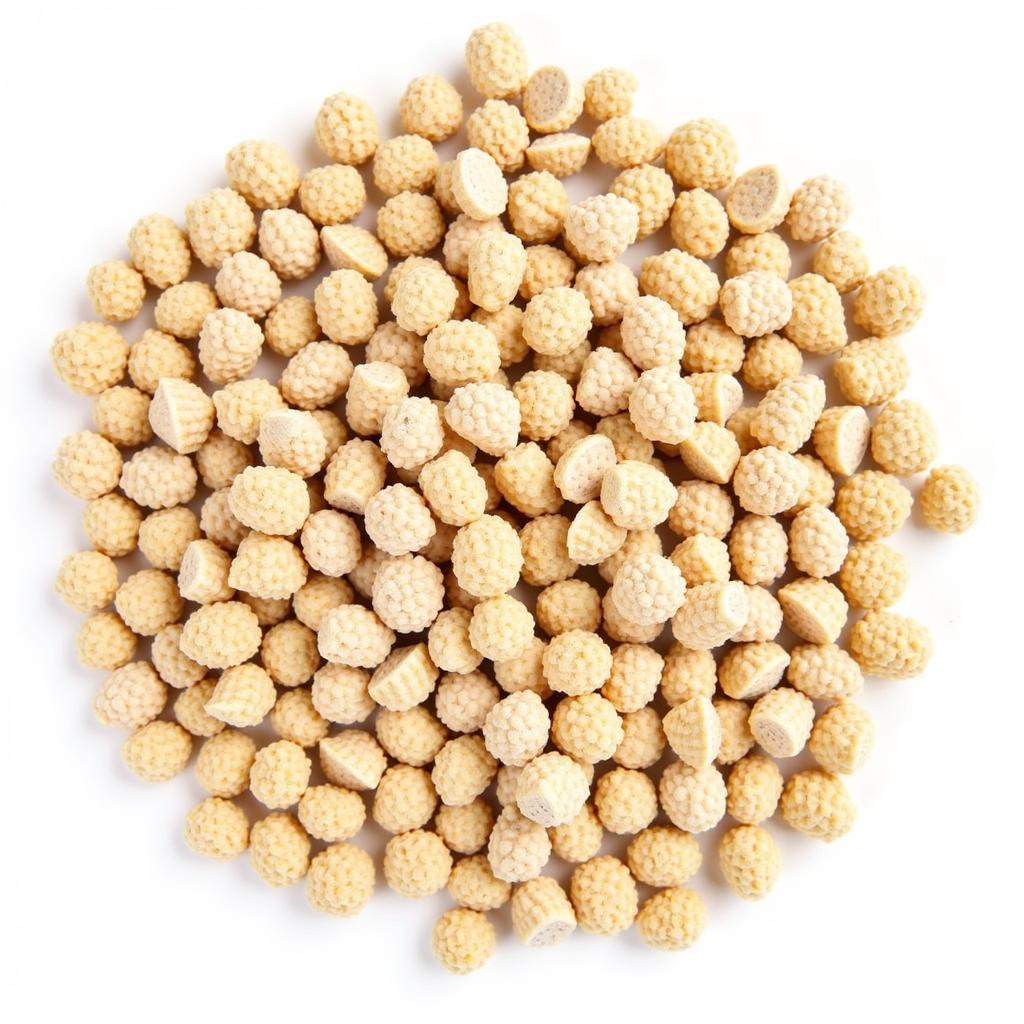Koi Wheat Germ Food is a highly sought-after dietary staple for koi enthusiasts looking to boost their fish’s health and vibrancy. It’s packed with essential nutrients, promoting growth, enhancing color, and bolstering the immune system. But with so many options available, understanding the benefits and selecting the right wheat germ food for your koi can be a challenge. Let’s dive into the world of koi wheat germ food and discover how this nutritional powerhouse can benefit your pond.
The Nutritional Benefits of Wheat Germ for Koi
Wheat germ, the heart of the wheat kernel, is a nutritional powerhouse containing a wealth of vitamins, minerals, and essential fatty acids. These nutrients are crucial for maintaining optimal koi health and supporting their growth throughout their lifecycle. Specifically, wheat germ is rich in Vitamin E, a potent antioxidant that protects cells from damage and supports a healthy immune system. It’s also a great source of B vitamins, which play a key role in energy production and metabolic function. The high protein content in wheat germ contributes to muscle development and overall growth, while essential fatty acids, like omega-3s, contribute to healthy skin and vibrant coloration. Including wheat germ in your koi’s diet can lead to improved growth rates, enhanced color intensity, and increased resistance to diseases.
For koi keepers looking for a high-quality wheat germ food, check out our wheat germ koi food.
Choosing the Right Koi Wheat Germ Food
Not all koi wheat germ foods are created equal. Quality, ingredients, and formulation play a significant role in determining the effectiveness of the food. Look for foods with high-quality wheat germ as the primary ingredient, avoiding fillers and artificial additives. Consider the protein content, ensuring it meets the needs of your koi’s growth stage. Check for the presence of essential fatty acids, like omega-3 and omega-6, which contribute to healthy skin and vibrant color. Also, consider the pellet size, selecting a size appropriate for the size of your koi. Reading reviews and seeking recommendations from experienced koi keepers can help you make informed decisions.
Why is wheat germ good for koi?
Wheat germ is beneficial for koi because it is packed with essential nutrients like Vitamin E, B vitamins, protein, and essential fatty acids. These nutrients contribute to a healthy immune system, energy production, growth, and vibrant coloration.
Incorporating Wheat Germ Food into Your Koi’s Diet
Introducing wheat germ food into your koi’s diet should be a gradual process to avoid digestive upset. Start by mixing a small amount of wheat germ food with their regular food and gradually increase the proportion over several days. Observe your koi for any signs of digestive issues, such as bloating or lethargy, and adjust the feeding schedule accordingly. Remember to feed your koi only what they can consume within a few minutes to avoid overfeeding and water quality issues. The feeding frequency and amount will depend on the water temperature and the age of your koi. During warmer months, you can feed them more frequently, while in colder months, reduce the feeding frequency and amount.
 Koi Fish Enjoying Wheat Germ Food
Koi Fish Enjoying Wheat Germ Food
Seasonal Considerations for Wheat Germ Feeding
The frequency and type of koi food, including wheat germ food, should be adjusted according to the season. During spring and fall, fall koi food is formulated to support the changing metabolic needs of the fish. In winter, reduce feeding frequency and switch to a koi winter food designed for lower temperatures. Remember to always monitor your water quality and adjust feeding accordingly.
Beyond Wheat Germ: A Balanced Diet for Optimal Health
While wheat germ food offers significant benefits, it shouldn’t be the sole component of your koi’s diet. A balanced diet consisting of a variety of high-quality koi foods is essential for ensuring they receive all the necessary nutrients. Consider incorporating other types of food, such as ultra balance premium koi food, to provide a complete nutritional profile.
 Different Types of Koi Food Pellets
Different Types of Koi Food Pellets
What are the signs of a healthy koi?
A healthy koi will exhibit vibrant colors, clear eyes, smooth skin, active swimming behavior, and a good appetite. They will also readily come to the surface for feeding.
“A balanced diet is key to maintaining healthy and vibrant koi,” says renowned aquatic veterinarian Dr. Emily Carter. “Wheat germ food is a valuable addition to their diet, but variety is crucial for providing all the essential nutrients.”
Where can I buy koi wheat germ food?
You can find high-quality koi fish food for sale at reputable pet stores, aquatic supply shops, and online retailers.
Conclusion
Koi wheat germ food offers a powerful nutritional boost for your pond fish, promoting growth, enhancing color, and bolstering their immune system. By choosing high-quality wheat germ food and incorporating it into a balanced diet, you can contribute to the overall health and vibrancy of your koi.
FAQ
- How often should I feed my koi wheat germ food?
- Can I feed my koi wheat germ food year-round?
- What is the ideal water temperature for feeding koi wheat germ food?
- How much wheat germ food should I feed my koi?
- What are the signs of overfeeding in koi?
- Can I mix wheat germ food with other types of koi food?
- What should I do if my koi refuse to eat wheat germ food?
Common Questions about Koi and their diet:
- What do Koi eat besides pellets?
- How to choose the right food for my Koi?
- Is it OK to feed Koi bread?
- Do Koi recognize their owners?
For further information, please visit our website and explore other related articles:
- Koi Winter Feeding Guide
- Choosing the Right Koi Food for Different Seasons
- The Importance of a Balanced Diet for Koi Fish
When you need assistance, please contact us via Phone: 02437655121, Email: minacones@gmail.com Or visit our address: 3PGH+8R9, ĐT70A, thôn Trung, Bắc Từ Liêm, Hà Nội, Việt Nam. We have a 24/7 customer service team.